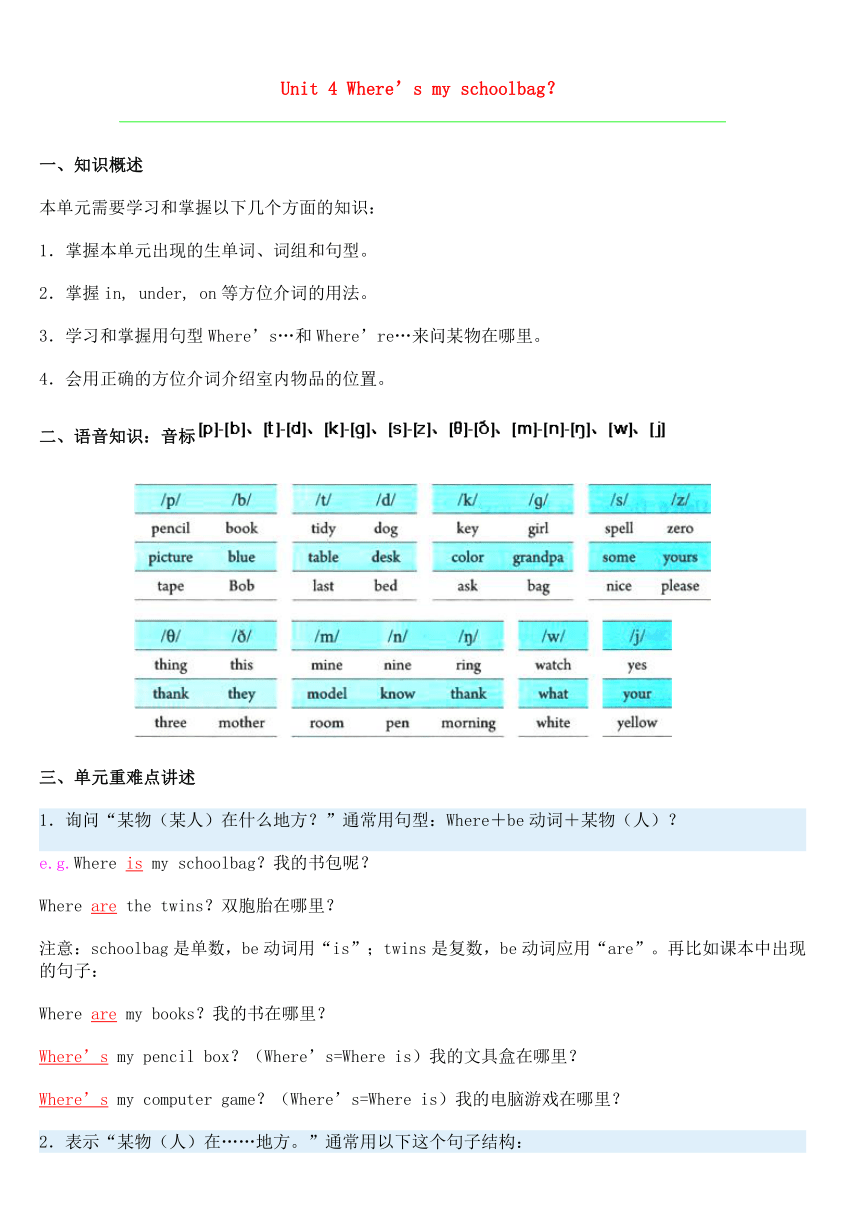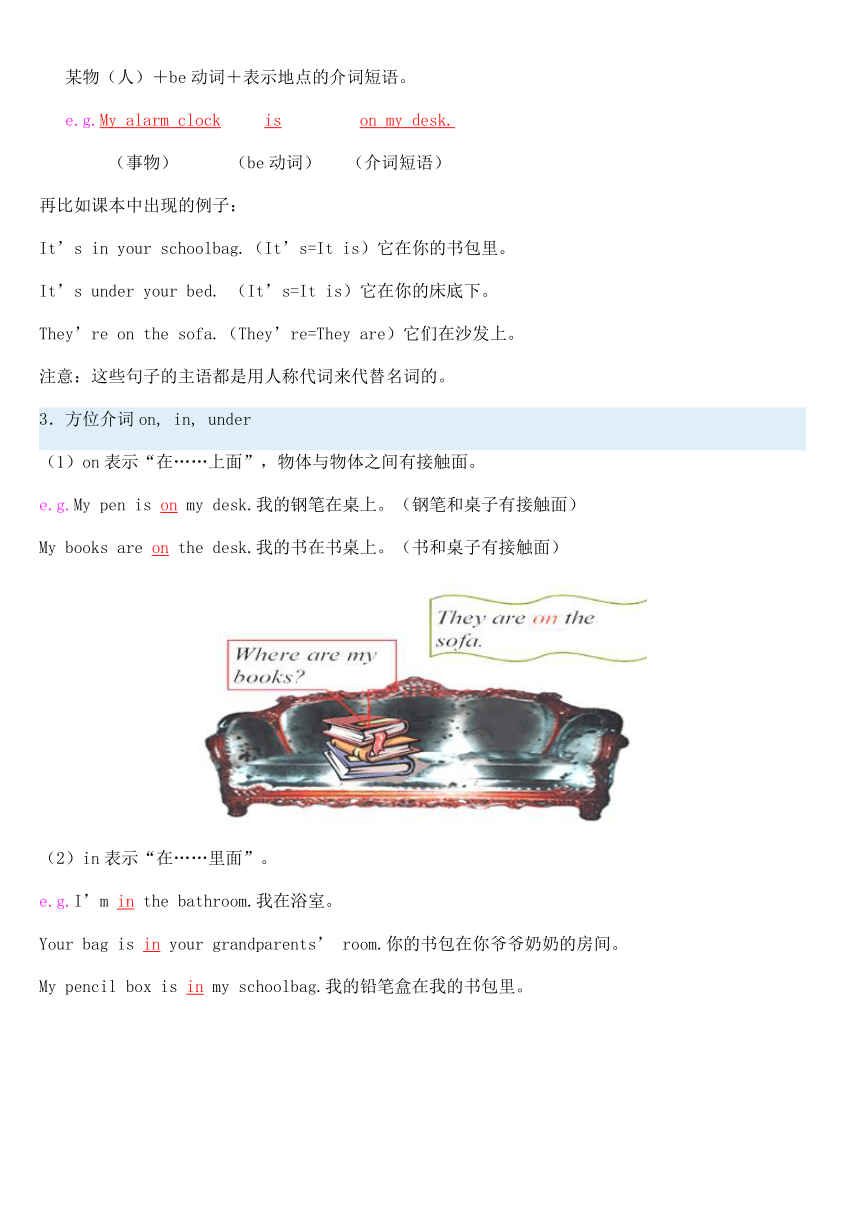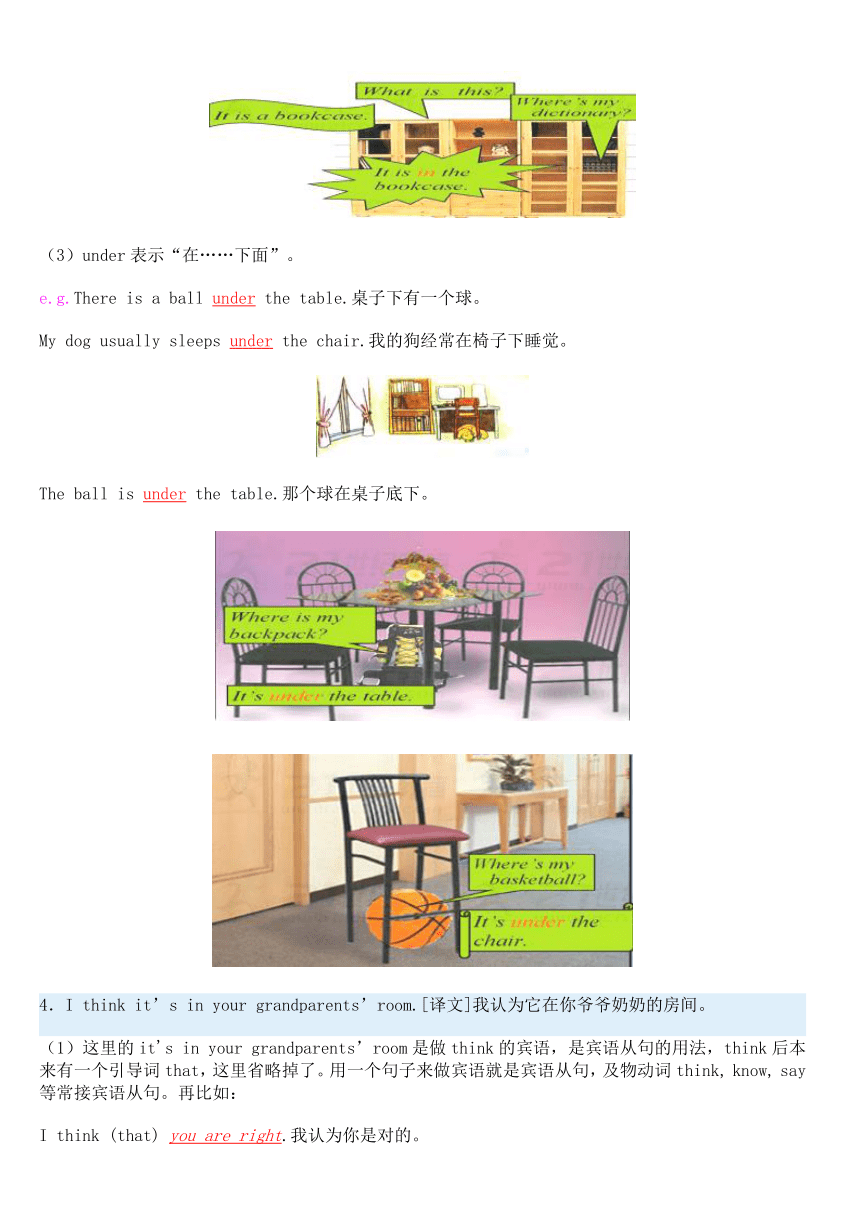Unit 4 Where’s my schoolbag?教案
文档属性
| 名称 | Unit 4 Where’s my schoolbag?教案 |  | |
| 格式 | zip | ||
| 文件大小 | 308.0KB | ||
| 资源类型 | 教案 | ||
| 版本资源 | 人教新目标(Go for it)版 | ||
| 科目 | 英语 | ||
| 更新时间 | 2017-09-08 16:38:30 | ||
图片预览



文档简介
Unit
4
Where’s
my
schoolbag?
一、知识概述
本单元需要学习和掌握以下几个方面的知识:
1.掌握本单元出现的生单词、词组和句型。
2.掌握in,
under,
on等方位介词的用法。
3.学习和掌握用句型Where’s…和Where’re…来问某物在哪里。
4.会用正确的方位介词介绍室内物品的位置。
二、语音知识:音标
三、单元重难点讲述
1.询问“某物(某人)在什么地方?”通常用句型:Where+be动词+某物(人)?
e.g.Where
is
my
schoolbag?我的书包呢?
Where
are
the
twins?双胞胎在哪里?
注意:schoolbag是单数,be动词用“is”;twins是复数,be动词应用“are”。再比如课本中出现的句子:
Where
are
my
books?我的书在哪里?
Where’s
my
pencil
box?(Where’s=Where
is)我的文具盒在哪里?
Where’s
my
computer
game?(Where’s=Where
is)我的电脑游戏在哪里?
2.表示“某物(人)在……地方。”通常用以下这个句子结构:
某物(人)+be动词+表示地点的介词短语。
e.g.My
alarm
clock
is
on
my
desk.
(事物)
(be动词)
(介词短语)
再比如课本中出现的例子:
It’s
in
your
schoolbag.(It’s=It
is)它在你的书包里。
It’s
under
your
bed.
(It’s=It
is)它在你的床底下。
They’re
on
the
sofa.(They’re=They
are)它们在沙发上。
注意:这些句子的主语都是用人称代词来代替名词的。
3.方位介词on,
in,
under
(1)on表示“在……上面”,物体与物体之间有接触面。
e.g.My
pen
is
on
my
desk.我的钢笔在桌上。(钢笔和桌子有接触面)
My
books
are
on
the
desk.我的书在书桌上。(书和桌子有接触面)
(2)in表示“在……里面”。
e.g.I’m
in
the
bathroom.我在浴室。
Your
bag
is
in
your
grandparents’
room.你的书包在你爷爷奶奶的房间。
My
pencil
box
is
in
my
schoolbag.我的铅笔盒在我的书包里。
(3)under表示“在……下面”。
e.g.There
is
a
ball
under
the
table.桌子下有一个球。
My
dog
usually
sleeps
under
the
chair.我的狗经常在椅子下睡觉。
The
ball
is
under
the
table.那个球在桌子底下。
4.I
think
it’s
in
your
grandparents’room.[译文]我认为它在你爷爷奶奶的房间。
(1)这里的it's
in
your
grandparents’room是做think的宾语,是宾语从句的用法,think后本来有一个引导词that,这里省略掉了。用一个句子来做宾语就是宾语从句,及物动词think,
know,
say等常接宾语从句。再比如:
I
think
(that)
you
are
right.我认为你是对的。
Everyone
knows
(that)
he
is
a
good
student.每个人都知道他是个好学生。
注意:在宾语从句中,当主句含有I/We
think时,从句的否定意义应在主句上变化(即否定的转移),一般疑问句也在主句上变化,从句无需变化。
e.g.I
don’t
think
he
can
swim.我认为他不会游泳。
I
don’t
think
they
are
right.我认为她们是不对的。
(2)这里的grandparents’是复数名词的所有格形式,因为复数形式以s结尾,所以直接加’构成所有格形式,再比如:
e.g.the
teachers’
office 老师们的办公室
my
parents’
bedroom
我父母的卧室
the
students’
classroom
学生们的教室
5.And
my
hat?[译文]我的帽子呢?
这里的and表示上句没有说完接着说,是一种口语表达,在此相当于Where
is
my
hat?
e.g.—Where
is
my
bag?我的书包在哪儿?
—It’s
on
your
bed.在你的床上。
—And
my
school
ID
card?我的学生证呢?
—It’s
on
your
bed,
too.它也在你的床上。
6.I
don’t
know.[译文]我不知道。
这是一个一般现在时的否定句。当含有行为动词时,构成否定句要用don’t(主语为第三人称单数时用单数形式doesn’t)。如果句中的谓语动词是系动词be(am,
is,
are)时,否定要在be后加not,即am
not,
is
not(isn’t),
are
not(aren’t)。do/does为助动词,无实际意义,只用来帮助构成疑问句、否定句。
e.g.I
don’t
think
so.我不这样认为。
He
doesn’t
know
my
name.他不知道我的名字。
I
don’t
have
a
bag.我没有书包。
He
isn’t
in
Class
Four.他不在四班。
注意:当别人问你事情,你不知道时,为了更有礼貌或委婉客气,可在I
don’t
know.前面加上Sorry.或I’m
sorry.。
e.g.—Where
is
my
ruler?我的尺子在哪里?
—Sorry,
I
don’t
know.对不起,我不知道。
7.I’m
tidy,
but
Gina
is
not.[译文]我很整洁,但是吉娜不这样。
tidy
adj.
整洁的;井井有条的
e.g.The
classroom
is
clean
and
tidy.
教室整齐清洁。
拓展:tidy
up整理,收拾。
but
conj.
但是。它是转折连词,用来连接具有转折关系的两个并列句。
e.g.She
likes
me,
but
I
don’t
like
her.
她喜欢我,但是我不喜欢她。
辨析:or,and与but
(1)or连词,表示选择关系。Either
you
or
he
is
right.
要么你要么他是对的。(2)and连词,意为“和”,连接两个并列的名词、代词或两个形容词。在否定句中用or。但如果前后名词都用no修饰,则可以用and。Tom
and
Jack
are
good
friends.
汤姆和杰克是好朋友。I
don’t
have
a
sister
or
brother.
我没有兄弟姐妹。I
have
no
sister
and
no
brother.
我没有兄弟姐妹。(3)but连词,意为“但是,可是”。The
bike
is
new,
but
it
doesn’t
work.
这辆自行车是新的,但它坏了。
理解下面这个句子:
I
like
singing
and
dancing
but
my
sister
doesn’t
like
singing
or
dancing.
我喜欢唱歌和跳舞,但我妹妹不喜欢唱歌和跳舞。
8.Gina’s
books
are
everywhere—on
her
bed,
on
the
sofa
and
under
the
chair.
[译文]吉娜的书到处都是——她的床上、沙发上,还有椅子下面。
everywhere
adv.
处处;到处;各个地方
everywhere相当于here
and
there。
e.g.The
girl’s
shoes
are
everywhere.
这个女孩的鞋子到处都是。
under
prep.
在……下
under后面可接名词或代词构成介词短语,表示位置。under的反义词是over。
under
the
bed在床下
拓展:under还可意为“低于;少于;在……以下”。
The
books
are
under
ten
yuan.
这些书低于10元。
辨析:under,below
(1)under表示“在……之下”时,指垂直的正下方。
The
baseball
is
under
the
chair.
棒球在椅子下面。
(2)below表示“在……之下”时,范围较广,不一定在正下方。
All
the
fields
are
below
the
plane.
所有的田地都在飞机之下。
4
Where’s
my
schoolbag?
一、知识概述
本单元需要学习和掌握以下几个方面的知识:
1.掌握本单元出现的生单词、词组和句型。
2.掌握in,
under,
on等方位介词的用法。
3.学习和掌握用句型Where’s…和Where’re…来问某物在哪里。
4.会用正确的方位介词介绍室内物品的位置。
二、语音知识:音标
三、单元重难点讲述
1.询问“某物(某人)在什么地方?”通常用句型:Where+be动词+某物(人)?
e.g.Where
is
my
schoolbag?我的书包呢?
Where
are
the
twins?双胞胎在哪里?
注意:schoolbag是单数,be动词用“is”;twins是复数,be动词应用“are”。再比如课本中出现的句子:
Where
are
my
books?我的书在哪里?
Where’s
my
pencil
box?(Where’s=Where
is)我的文具盒在哪里?
Where’s
my
computer
game?(Where’s=Where
is)我的电脑游戏在哪里?
2.表示“某物(人)在……地方。”通常用以下这个句子结构:
某物(人)+be动词+表示地点的介词短语。
e.g.My
alarm
clock
is
on
my
desk.
(事物)
(be动词)
(介词短语)
再比如课本中出现的例子:
It’s
in
your
schoolbag.(It’s=It
is)它在你的书包里。
It’s
under
your
bed.
(It’s=It
is)它在你的床底下。
They’re
on
the
sofa.(They’re=They
are)它们在沙发上。
注意:这些句子的主语都是用人称代词来代替名词的。
3.方位介词on,
in,
under
(1)on表示“在……上面”,物体与物体之间有接触面。
e.g.My
pen
is
on
my
desk.我的钢笔在桌上。(钢笔和桌子有接触面)
My
books
are
on
the
desk.我的书在书桌上。(书和桌子有接触面)
(2)in表示“在……里面”。
e.g.I’m
in
the
bathroom.我在浴室。
Your
bag
is
in
your
grandparents’
room.你的书包在你爷爷奶奶的房间。
My
pencil
box
is
in
my
schoolbag.我的铅笔盒在我的书包里。
(3)under表示“在……下面”。
e.g.There
is
a
ball
under
the
table.桌子下有一个球。
My
dog
usually
sleeps
under
the
chair.我的狗经常在椅子下睡觉。
The
ball
is
under
the
table.那个球在桌子底下。
4.I
think
it’s
in
your
grandparents’room.[译文]我认为它在你爷爷奶奶的房间。
(1)这里的it's
in
your
grandparents’room是做think的宾语,是宾语从句的用法,think后本来有一个引导词that,这里省略掉了。用一个句子来做宾语就是宾语从句,及物动词think,
know,
say等常接宾语从句。再比如:
I
think
(that)
you
are
right.我认为你是对的。
Everyone
knows
(that)
he
is
a
good
student.每个人都知道他是个好学生。
注意:在宾语从句中,当主句含有I/We
think时,从句的否定意义应在主句上变化(即否定的转移),一般疑问句也在主句上变化,从句无需变化。
e.g.I
don’t
think
he
can
swim.我认为他不会游泳。
I
don’t
think
they
are
right.我认为她们是不对的。
(2)这里的grandparents’是复数名词的所有格形式,因为复数形式以s结尾,所以直接加’构成所有格形式,再比如:
e.g.the
teachers’
office 老师们的办公室
my
parents’
bedroom
我父母的卧室
the
students’
classroom
学生们的教室
5.And
my
hat?[译文]我的帽子呢?
这里的and表示上句没有说完接着说,是一种口语表达,在此相当于Where
is
my
hat?
e.g.—Where
is
my
bag?我的书包在哪儿?
—It’s
on
your
bed.在你的床上。
—And
my
school
ID
card?我的学生证呢?
—It’s
on
your
bed,
too.它也在你的床上。
6.I
don’t
know.[译文]我不知道。
这是一个一般现在时的否定句。当含有行为动词时,构成否定句要用don’t(主语为第三人称单数时用单数形式doesn’t)。如果句中的谓语动词是系动词be(am,
is,
are)时,否定要在be后加not,即am
not,
is
not(isn’t),
are
not(aren’t)。do/does为助动词,无实际意义,只用来帮助构成疑问句、否定句。
e.g.I
don’t
think
so.我不这样认为。
He
doesn’t
know
my
name.他不知道我的名字。
I
don’t
have
a
bag.我没有书包。
He
isn’t
in
Class
Four.他不在四班。
注意:当别人问你事情,你不知道时,为了更有礼貌或委婉客气,可在I
don’t
know.前面加上Sorry.或I’m
sorry.。
e.g.—Where
is
my
ruler?我的尺子在哪里?
—Sorry,
I
don’t
know.对不起,我不知道。
7.I’m
tidy,
but
Gina
is
not.[译文]我很整洁,但是吉娜不这样。
tidy
adj.
整洁的;井井有条的
e.g.The
classroom
is
clean
and
tidy.
教室整齐清洁。
拓展:tidy
up整理,收拾。
but
conj.
但是。它是转折连词,用来连接具有转折关系的两个并列句。
e.g.She
likes
me,
but
I
don’t
like
her.
她喜欢我,但是我不喜欢她。
辨析:or,and与but
(1)or连词,表示选择关系。Either
you
or
he
is
right.
要么你要么他是对的。(2)and连词,意为“和”,连接两个并列的名词、代词或两个形容词。在否定句中用or。但如果前后名词都用no修饰,则可以用and。Tom
and
Jack
are
good
friends.
汤姆和杰克是好朋友。I
don’t
have
a
sister
or
brother.
我没有兄弟姐妹。I
have
no
sister
and
no
brother.
我没有兄弟姐妹。(3)but连词,意为“但是,可是”。The
bike
is
new,
but
it
doesn’t
work.
这辆自行车是新的,但它坏了。
理解下面这个句子:
I
like
singing
and
dancing
but
my
sister
doesn’t
like
singing
or
dancing.
我喜欢唱歌和跳舞,但我妹妹不喜欢唱歌和跳舞。
8.Gina’s
books
are
everywhere—on
her
bed,
on
the
sofa
and
under
the
chair.
[译文]吉娜的书到处都是——她的床上、沙发上,还有椅子下面。
everywhere
adv.
处处;到处;各个地方
everywhere相当于here
and
there。
e.g.The
girl’s
shoes
are
everywhere.
这个女孩的鞋子到处都是。
under
prep.
在……下
under后面可接名词或代词构成介词短语,表示位置。under的反义词是over。
under
the
bed在床下
拓展:under还可意为“低于;少于;在……以下”。
The
books
are
under
ten
yuan.
这些书低于10元。
辨析:under,below
(1)under表示“在……之下”时,指垂直的正下方。
The
baseball
is
under
the
chair.
棒球在椅子下面。
(2)below表示“在……之下”时,范围较广,不一定在正下方。
All
the
fields
are
below
the
plane.
所有的田地都在飞机之下。
同课章节目录
- starters 预备篇(2012秋审查)
- Unit 1 Good morning !
- Unit 2 What’s this in English?
- Unit 3 What color is it ?
- Unit 1 My name's Gina.
- Section A
- Section B
- Unit 2 This is my sister.
- Section A
- Section B
- Unit 3 Is this your pencil?
- Section A
- Section B
- Unit 4 Where's my schoolbag?
- Section A
- Section B
- Unit 5 Do you have a soccer ball?
- Section A
- Section B
- Unit 6 Do you like bananas?
- Section A
- Section B
- Unit 7 How much are these socks?
- Section A
- Section B
- Unit 8 When is your birthday?
- Section A
- Section B
- Unit 9 My favorite subject is science.
- Section A
- Section B
